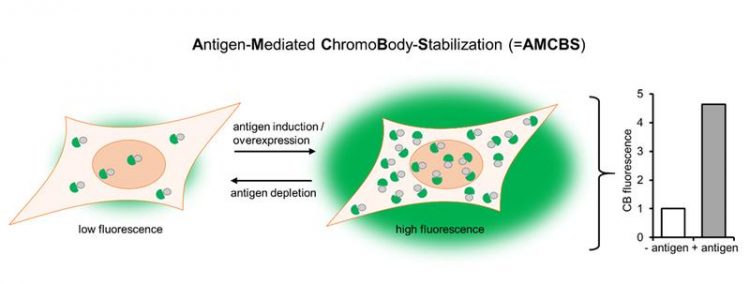Brought to light – chromobodies reveal changes in endogenous protein concentration in living cells

Antigen-Mediated-ChromoBody-Stabilization (AMCBS) NMI
In a study now published in Molecular & Cellular Proteomics, Keller et al. describe how fluorescently labeled intrabodies (so-called chromobodies) are stabilized in the presence of their target proteins.
Based on this newly uncovered property of chromobodies, the authors present a broadly applicable strategy to optimize chromobodies in order to visualize and measure changes of endogenous target proteins within living cells.
Currently available procedures to measure cellular protein concentration such as quantitative immunoblotting or mass spectrometry analysis are very laborious and time consuming.
Moreover, these approaches require destructive sample preparation and thus only deliver results at a single point in time.
“Our new approach using antigen-mediated chromobody stabilization (AMCBS) allows us to continuously visualize and quantify dynamic changes of specific endogenous proteins directly within living cells – something that could not be done before”, stated Bettina-Maria Keller, the study´s first author.
“We expect this approach to enable unprecedented insights into the dynamic regulation of proteins, e.g. during cellular signaling, cell differentiation, or upon drug action”.
Publication:
Chromobodies to quantify changes of endogenous protein concentration in living cells
Molecular & Cellular Proteomics September 18, 2018, mcp.TIR118.000914; https://doi.org/10.1074/mcp.TIR118.000914
Prof. Dr. Ulrich Rothbauer
NMI /Universität Tübingen
Markwiesenstrasse 55
72770 Reutlingen
Email: ulrich.rothbauer@nmi.de
ulrich.rothbauer@uni-tuebingen.de
Tel.: +49 (0)7121 30 415
Chromobodies to quantify changes of endogenous protein concentration in living cells
Molecular & Cellular Proteomics September 18, 2018, mcp.TIR118.000914; https://doi.org/10.1074/mcp.TIR118.000914
Media Contact
All latest news from the category: Life Sciences and Chemistry
Articles and reports from the Life Sciences and chemistry area deal with applied and basic research into modern biology, chemistry and human medicine.
Valuable information can be found on a range of life sciences fields including bacteriology, biochemistry, bionics, bioinformatics, biophysics, biotechnology, genetics, geobotany, human biology, marine biology, microbiology, molecular biology, cellular biology, zoology, bioinorganic chemistry, microchemistry and environmental chemistry.
Newest articles

Combatting disruptive ‘noise’ in quantum communication
In a significant milestone for quantum communication technology, an experiment has demonstrated how networks can be leveraged to combat disruptive ‘noise’ in quantum communications. The international effort led by researchers…

Stretchable quantum dot display
Intrinsically stretchable quantum dot-based light-emitting diodes achieved record-breaking performance. A team of South Korean scientists led by Professor KIM Dae-Hyeong of the Center for Nanoparticle Research within the Institute for…

Internet can achieve quantum speed with light saved as sound
Researchers at the University of Copenhagen’s Niels Bohr Institute have developed a new way to create quantum memory: A small drum can store data sent with light in its sonic…





















